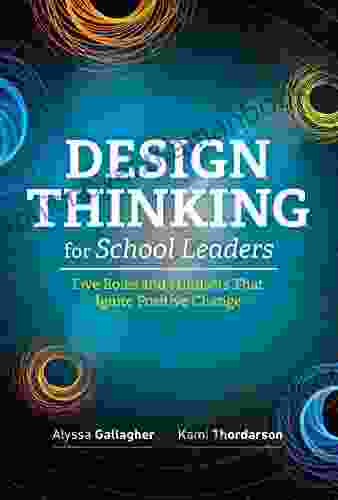Design Thinking for School Leaders: A Comprehensive Guide to Unlocking Student Potential

4.7 out of 5
| Language | : | English |
| File size | : | 2385 KB |
| Text-to-Speech | : | Enabled |
| Screen Reader | : | Supported |
| Enhanced typesetting | : | Enabled |
| Word Wise | : | Enabled |
| Print length | : | 226 pages |
In the ever-evolving landscape of education, school leaders are tasked with the monumental responsibility of cultivating a dynamic and engaging learning environment for their students. Design Thinking, an innovative problem-solving approach, has emerged as a powerful tool for school leaders to navigate the challenges and opportunities of the 21st century classroom.
This comprehensive guide explores the principles, tools, and case studies of Design Thinking for school leaders. By embracing this human-centered approach, educational leaders can create meaningful and transformative learning experiences that foster critical thinking, creativity, and problem-solving skills in their students.
Principles of Design Thinking
Design Thinking is a non-linear, iterative process that emphasizes empathy, collaboration, and experimentation. Its core principles include:
- Emphasize Human Needs: Design Thinking places the user (in this case, the students) at the center of the problem-solving process.
- Foster Collaboration: It encourages teamwork and cross-functional collaboration to generate diverse perspectives and solutions.
- Embrace Iteration: Design Thinking is an iterative process that involves prototyping, testing, and refining ideas.
- Seek Radical Innovation: It challenges conventional solutions and seeks out transformative ideas that break existing molds.
The Design Thinking Process
The Design Thinking process consists of five distinct stages:
1. Empathize: Understand the needs, motivations, and challenges of the intended users.
2. Define: Clearly articulate the problem or opportunity that needs to be addressed.
3. Ideate: Generate a wide range of creative solutions and ideas.
4. Prototype: Develop tangible representations of the proposed solutions to test and refine.
5. Test: Evaluate the prototypes with users and gather feedback to improve the solution.
Tools for Design Thinking
Various tools can facilitate Design Thinking in the education context:
- Empathy Maps: Visualize the user's needs, thoughts, and experiences.
- Problem Statements: Concisely capture the problem to be solved.
- Ideation Techniques: Brainstorming, mind mapping, and SCAMPER.
- Prototyping Methods: Paper prototyping, role-playing, and digital mockups.
- Feedback Mechanisms: Surveys, interviews, and user testing.
Case Studies in Education
Design Thinking has been successfully implemented in schools worldwide, leading to transformative results:
- The Khan Lab School: Used Design Thinking to develop personalized learning plans for each student.
- High Tech High: Created a student-centered school model that emphasizes project-based learning.
- IDEO for Education: Partnered with schools to design innovative learning spaces and curriculum.
Benefits of Design Thinking for School Leaders
By incorporating Design Thinking into their leadership practice, school leaders can reap numerous benefits:
- Improved Problem-Solving: Equips leaders with a structured approach to addressing complex educational challenges.
- Enhanced Student Engagement: Fosters student-centered learning and makes education more relevant and meaningful.
- Greater Innovation: Encourages leaders to think outside the box and develop creative solutions.
- Improved Leadership Skills: Strengthens collaboration, empathy, and communication skills.
Design Thinking is an invaluable tool for school leaders who are committed to driving innovation and creating a vibrant learning environment for their students. By embracing its principles, tools, and iterative process, leaders can unlock student potential, foster critical thinking, and cultivate a lifelong love for learning.
As the future of education unfolds, Design Thinking will undoubtedly play an increasingly significant role in shaping the educational landscape. School leaders who embrace this transformative approach will be at the forefront of creating a dynamic and engaging learning experience for the next generation of students.
4.7 out of 5
| Language | : | English |
| File size | : | 2385 KB |
| Text-to-Speech | : | Enabled |
| Screen Reader | : | Supported |
| Enhanced typesetting | : | Enabled |
| Word Wise | : | Enabled |
| Print length | : | 226 pages |
Do you want to contribute by writing guest posts on this blog?
Please contact us and send us a resume of previous articles that you have written.
 Top Book
Top Book Novel
Novel Fiction
Fiction Nonfiction
Nonfiction Literature
Literature Paperback
Paperback Hardcover
Hardcover E-book
E-book Audiobook
Audiobook Bestseller
Bestseller Classic
Classic Mystery
Mystery Thriller
Thriller Romance
Romance Fantasy
Fantasy Science Fiction
Science Fiction Biography
Biography Memoir
Memoir Autobiography
Autobiography Poetry
Poetry Drama
Drama Historical Fiction
Historical Fiction Self-help
Self-help Young Adult
Young Adult Childrens Books
Childrens Books Graphic Novel
Graphic Novel Anthology
Anthology Series
Series Encyclopedia
Encyclopedia Reference
Reference Guidebook
Guidebook Textbook
Textbook Workbook
Workbook Journal
Journal Diary
Diary Manuscript
Manuscript Folio
Folio Pulp Fiction
Pulp Fiction Short Stories
Short Stories Fairy Tales
Fairy Tales Fables
Fables Mythology
Mythology Philosophy
Philosophy Religion
Religion Spirituality
Spirituality Essays
Essays Critique
Critique Commentary
Commentary Glossary
Glossary Bibliography
Bibliography Index
Index Table of Contents
Table of Contents Preface
Preface Introduction
Introduction Foreword
Foreword Afterword
Afterword Appendices
Appendices Annotations
Annotations Footnotes
Footnotes Epilogue
Epilogue Prologue
Prologue Bill Vanpatten
Bill Vanpatten Trisha Yearwood
Trisha Yearwood Megan Haskell
Megan Haskell Anandi Sano
Anandi Sano Alina Owais
Alina Owais David Olarinoye
David Olarinoye Amanda Lovelace
Amanda Lovelace Bronwyn Houldsworth
Bronwyn Houldsworth Jeremy Bailenson
Jeremy Bailenson J A Konrath
J A Konrath Melanie Shawn
Melanie Shawn Gianna Shamone
Gianna Shamone Sonja Dewing
Sonja Dewing Marlon S Hayes
Marlon S Hayes Christine Feehan
Christine Feehan Aline Cristina Moreira
Aline Cristina Moreira Faith Hunter
Faith Hunter Geno Allen
Geno Allen Joel Austin
Joel Austin James Lee
James Lee
Light bulbAdvertise smarter! Our strategic ad space ensures maximum exposure. Reserve your spot today!

 Maurice ParkerThe Successful Teacher Handbook: Strategies and Resources for the Modern...
Maurice ParkerThe Successful Teacher Handbook: Strategies and Resources for the Modern... Jessie CoxFollow ·16.3k
Jessie CoxFollow ·16.3k Duane KellyFollow ·4.7k
Duane KellyFollow ·4.7k Cade SimmonsFollow ·18k
Cade SimmonsFollow ·18k Dashawn HayesFollow ·2.1k
Dashawn HayesFollow ·2.1k Douglas FosterFollow ·17.9k
Douglas FosterFollow ·17.9k Isaac AsimovFollow ·3.4k
Isaac AsimovFollow ·3.4k Langston HughesFollow ·4.5k
Langston HughesFollow ·4.5k Allen GinsbergFollow ·10.9k
Allen GinsbergFollow ·10.9k

 Rex Hayes
Rex HayesWorld of Dead Volume Issue: An In-Depth Analysis
The World of Dead volume issue...

 Nathan Reed
Nathan ReedHard Lessons Learned from ERP Rollouts: A Hivemind...
Enterprise...

 Fernando Bell
Fernando BellWith the Light, Vol. 1: Illuminating the Extraordinary...
The advent of parenthood is a...

 Wesley Reed
Wesley ReedNo Helping Hand: True Story of Deadly Waves
In December 2004,...

 Ruben Cox
Ruben CoxIntroduction to Electrodynamics by David Griffiths: A...
to Electrodynamics by...
4.7 out of 5
| Language | : | English |
| File size | : | 2385 KB |
| Text-to-Speech | : | Enabled |
| Screen Reader | : | Supported |
| Enhanced typesetting | : | Enabled |
| Word Wise | : | Enabled |
| Print length | : | 226 pages |











